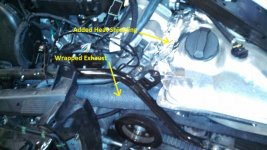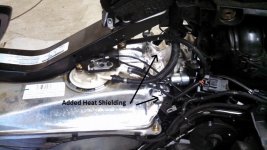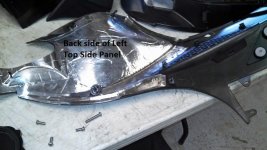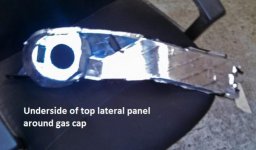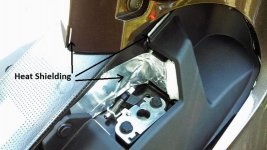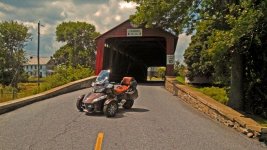robmorg
New member
No More "HOT SEAT"
I've resolved the upper heat problem on my 2013 RT to what is now an acceptable level. Of course you're never going to stop it all, but at least it's to the point where I can ride for many hours now without my thighs getting cooked.
I know there have been a lot of posts about "taming the dragon" and I've read most of them. One of the better ones IMO was Jerbear's recent thread, "The Dragon is Dead".
After a good bit of thought, I decided to ignore the radiator area down by my my right foot. It's never bothered me all that much, as I ride with jeans, and don't ever wear light weight socks or shoes. More importantly, I've never liked the idea of installing a heat shield down there that would likely direct more heat into the engine compartment, or removing or cutting holes in the bottom pan. The heat that has always bothered me much more is the heat coming up around the side panels and the seat which tends to fry my thighs as I ride. So that's what I've concentrated on.
JT's filter replacement fix may be a good option for many and I almost went that route. But in the end, I decided against that as well. I didn't want to jeopardize my 3-year extended warranty (which, right or wrong, my dealer said would be the case), and I know I would not be happy with the louder engine noise, although many don't mind that - especially with JT's new muffler installed on the air filter.
So I basically worked with my dealer to accomplish three modifications...
At the same time, we did the ECM firmware update outlined in Warranty Bulletin 2013-9. Apparently what that does is to enrich the fuel mixture at idle and slow speeds, which eliminates some of the heat coming up around the seat when you are going slow (like in city traffic).
The past two days, it's been in the 90's here, so I've taken some long rides to assess the results. Of course you are always going to feel some heat when you are sitting on top of a hot engine - especially while stalled in traffic. But for the most part, I've conquered the problem to the point that the remaining heat around the seat is down to where it is no longer objectionable. Before the mods, the four panels that we lined with reflective heat tape were always too hot to touch, and that is no longer the case. I believe that wrapping the headers is allowing a good bit of exhaust heat to flow out through the cat and muffler, thereby keeping both the engine compartment and the gas tank considerably cooler.
I've attached some picture below for reference.
My next step is to order the Lamonster Cat Bypass Pipe from Pit Bull Powersports. I'll cover that with heat shielding exhaust wrap before installing it, just like we put on the header pipes. That should make even more difference - especially toward reducing heat at the gas tank.
UPDATE: I did do the cat bypass in December, 2014. It has made a significant difference in the amount of heat the fuel tank is subjected to, as well as heat coming up around the seat. More details are in this thread.

Also, while the Spyder was in the shop, we installed Value Accessories' front bumper guard, BajaRon's beefed up sway bar and Keim joint links, and did the laser alignment. It's like I've got a brand new and improved Spyder now. :clap: I can't keep off of it.
I've resolved the upper heat problem on my 2013 RT to what is now an acceptable level. Of course you're never going to stop it all, but at least it's to the point where I can ride for many hours now without my thighs getting cooked.
I know there have been a lot of posts about "taming the dragon" and I've read most of them. One of the better ones IMO was Jerbear's recent thread, "The Dragon is Dead".
After a good bit of thought, I decided to ignore the radiator area down by my my right foot. It's never bothered me all that much, as I ride with jeans, and don't ever wear light weight socks or shoes. More importantly, I've never liked the idea of installing a heat shield down there that would likely direct more heat into the engine compartment, or removing or cutting holes in the bottom pan. The heat that has always bothered me much more is the heat coming up around the side panels and the seat which tends to fry my thighs as I ride. So that's what I've concentrated on.
JT's filter replacement fix may be a good option for many and I almost went that route. But in the end, I decided against that as well. I didn't want to jeopardize my 3-year extended warranty (which, right or wrong, my dealer said would be the case), and I know I would not be happy with the louder engine noise, although many don't mind that - especially with JT's new muffler installed on the air filter.
So I basically worked with my dealer to accomplish three modifications...
- First I had them wrap both exhaust headers with exhaust tape. The front header that runs all along the left side of the engine compartment is the one most responsible for the seat heat, and as you can see in the picture, it comes all the way back to the gas tank before it takes a 90 deg turn down to the cat.
- Then I added heat reflective tape to the backs of both top side panels (the panels that go under the front of the seat and around the glove box). We were careful to leave the vents in those panels open, but covered everything aft of there back toward the seat. Also completely covered the backs of both and the black upper lateral panels that go under the seat and above the gas tank. We used heat reflective tape, rather than heat insulation, so as not to take up any more room behind the panels than necessary.
- And finally we devised "double sided" heat tape shields (using basic heat reflective tape back-to-back) between the engine and the gas tank to block/reflect heat coming up around the tank to the seat area. Did this around the glove box as well, and where the two side panels come together in the middle. Also used this concept to block off all the open areas in the lateral panels under the seat - especially the openings for the helmet tabs and around the seat lock on the right panel.
At the same time, we did the ECM firmware update outlined in Warranty Bulletin 2013-9. Apparently what that does is to enrich the fuel mixture at idle and slow speeds, which eliminates some of the heat coming up around the seat when you are going slow (like in city traffic).
The past two days, it's been in the 90's here, so I've taken some long rides to assess the results. Of course you are always going to feel some heat when you are sitting on top of a hot engine - especially while stalled in traffic. But for the most part, I've conquered the problem to the point that the remaining heat around the seat is down to where it is no longer objectionable. Before the mods, the four panels that we lined with reflective heat tape were always too hot to touch, and that is no longer the case. I believe that wrapping the headers is allowing a good bit of exhaust heat to flow out through the cat and muffler, thereby keeping both the engine compartment and the gas tank considerably cooler.
I've attached some picture below for reference.
My next step is to order the Lamonster Cat Bypass Pipe from Pit Bull Powersports. I'll cover that with heat shielding exhaust wrap before installing it, just like we put on the header pipes. That should make even more difference - especially toward reducing heat at the gas tank.
UPDATE: I did do the cat bypass in December, 2014. It has made a significant difference in the amount of heat the fuel tank is subjected to, as well as heat coming up around the seat. More details are in this thread.
Also, while the Spyder was in the shop, we installed Value Accessories' front bumper guard, BajaRon's beefed up sway bar and Keim joint links, and did the laser alignment. It's like I've got a brand new and improved Spyder now. :clap: I can't keep off of it.
Attachments
Last edited:

